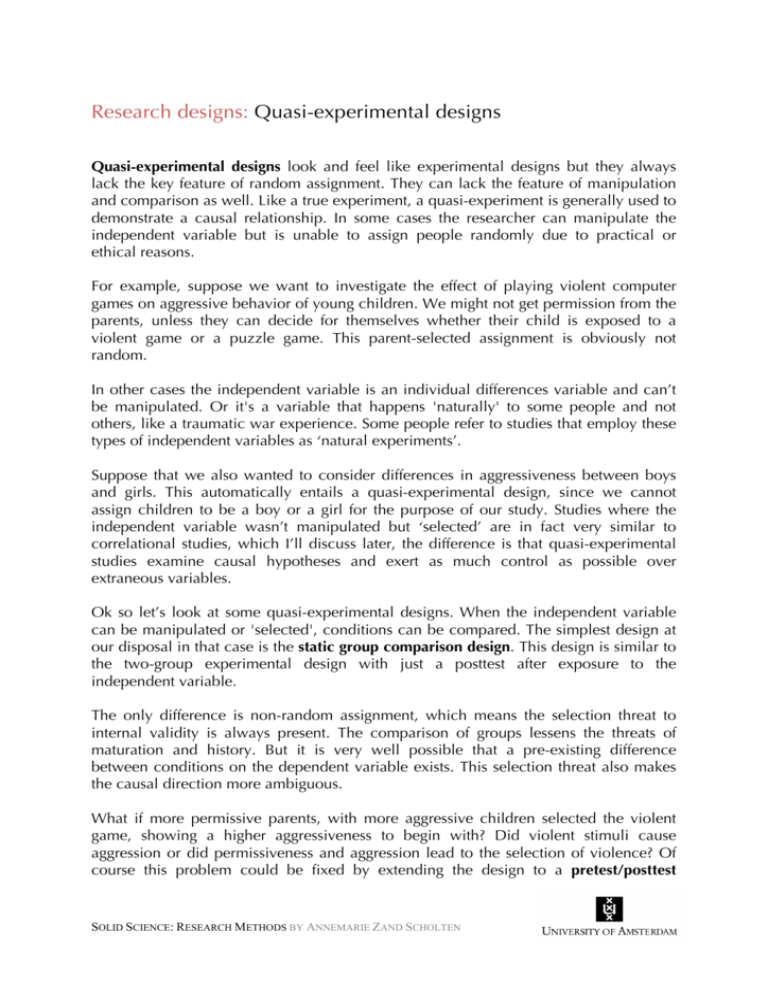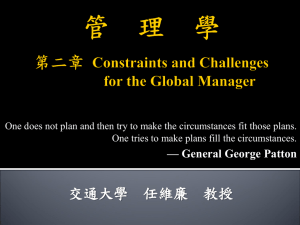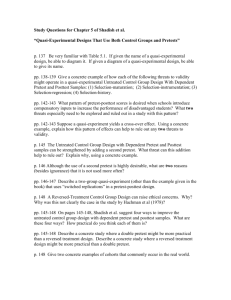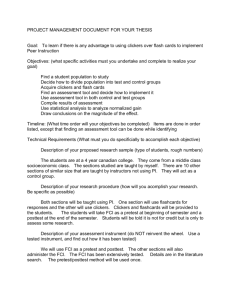Quasi-experimental designs
advertisement

Research designs: Quasi-experimental designs Quasi-experimental designs look and feel like experimental designs but they always lack the key feature of random assignment. They can lack the feature of manipulation and comparison as well. Like a true experiment, a quasi-experiment is generally used to demonstrate a causal relationship. In some cases the researcher can manipulate the independent variable but is unable to assign people randomly due to practical or ethical reasons. For example, suppose we want to investigate the effect of playing violent computer games on aggressive behavior of young children. We might not get permission from the parents, unless they can decide for themselves whether their child is exposed to a violent game or a puzzle game. This parent-selected assignment is obviously not random. In other cases the independent variable is an individual differences variable and can’t be manipulated. Or it's a variable that happens 'naturally' to some people and not others, like a traumatic war experience. Some people refer to studies that employ these types of independent variables as ‘natural experiments’. Suppose that we also wanted to consider differences in aggressiveness between boys and girls. This automatically entails a quasi-experimental design, since we cannot assign children to be a boy or a girl for the purpose of our study. Studies where the independent variable wasn’t manipulated but ‘selected’ are in fact very similar to correlational studies, which I’ll discuss later, the difference is that quasi-experimental studies examine causal hypotheses and exert as much control as possible over extraneous variables. Ok so let’s look at some quasi-experimental designs. When the independent variable can be manipulated or 'selected', conditions can be compared. The simplest design at our disposal in that case is the static group comparison design. This design is similar to the two-group experimental design with just a posttest after exposure to the independent variable. The only difference is non-random assignment, which means the selection threat to internal validity is always present. The comparison of groups lessens the threats of maturation and history. But it is very well possible that a pre-existing difference between conditions on the dependent variable exists. This selection threat also makes the causal direction more ambiguous. What if more permissive parents, with more aggressive children selected the violent game, showing a higher aggressiveness to begin with? Did violent stimuli cause aggression or did permissiveness and aggression lead to the selection of violence? Of course this problem could be fixed by extending the design to a pretest/posttest SOLID SCIENCE: RESEARCH METHODS BY ANNEMARIE ZAND SCHOLTEN nonequivalent control group design simply by adding a pretest. With this design we're able to determine whether there were any pre-existing differences on the dependent variable. If we can show that such differences don’t exist, we've firmly disambiguated the causal order. We can also assess the size of any maturation effects. Unfortunately it’s not always possible to use a control group. In that case the only thing you can do is at least establish temporal precedence of the cause by using a one-group pretest/posttest design. All the other threats to internal validity still apply though. One way to improve on the one group pretest/posttest design is to include more measurements of the dependent variable before and after exposure to the independent variable. We refer to this as an interrupted time-series design. More observations before and after the ‘treatment’ allow you to assess any natural change in the dependent variable. If the change is gradual with a sudden jump from just before to just after the ‘treatment’, we can rule out - at least to some extent - the threats of maturation and history. Suppose we only have access to the violent-game group but we have measurements at several time points for them. Aggressiveness increases slightly during the entire study. The change is the same just before and after exposure to the violent game, indicating that there was just no effect on aggressiveness. Now consider these results: Aggressiveness doesn’t change until the violent game is played. Immediately after, aggressiveness remains stable at a higher level, indicating a long-lasting effect. Things could also look like this: Aggressiveness increases slightly until after the violent game is played. And the results show a jump in aggressiveness only after exposure and the same slight increase after that. This might indicate a natural increase and effect of violent game-play. Of course it would be wise to check whether any other event occurred right at the sudden jump that might form a history threat to the internal validity. One way to check whether there truly is an effect and not a history effect is to use a replicated interrupted time-series design. This design adds a second group of participants for whom the dependent variable is measured at the same time points, but no ‘treatment‘ is administered. This is basically a more complicated version of the pretest/posttest nonequivalent control group design. Consider this outcome: if we see the same pattern for the second group there’s probably a history threat present. The design could also be implemented by exposing a second group to the same ‘treatment’ but at a different time than the first group. Consider this outcome: if the effect also shows if the intervention is presented just a little bit later, we can be more sure it was actually caused by the violent game-play. SOLID SCIENCE: RESEARCH METHODS BY ANNEMARIE ZAND SCHOLTEN SOLID SCIENCE: RESEARCH METHODS BY ANNEMARIE ZAND SCHOLTEN







